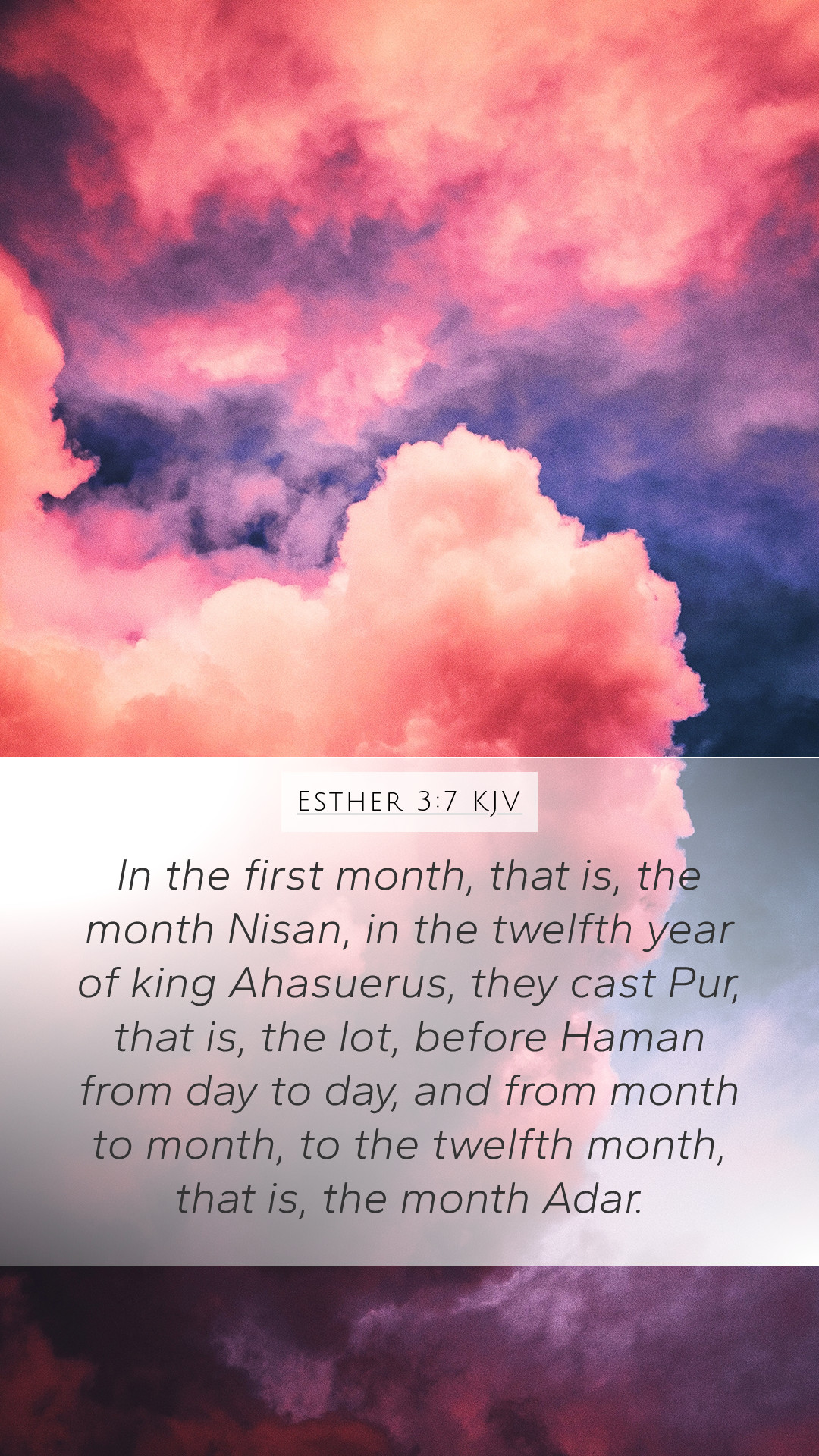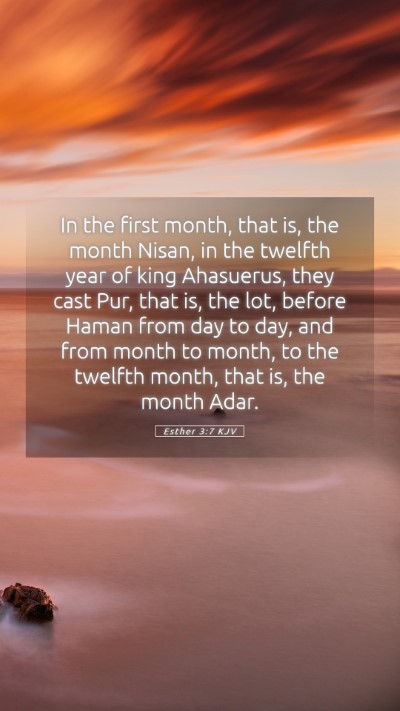Old Testament
Genesis Exodus Leviticus Numbers Deuteronomy Joshua Judges Ruth 1 Samuel 2 Samuel 1 Kings 2 Kings 1 Chronicles 2 Chronicles Ezra Nehemiah Esther Job Psalms Proverbs Ecclesiastes Song of Solomon Isaiah Jeremiah Lamentations Ezekiel Daniel Hosea Joel Amos Obadiah Jonah Micah Nahum Habakkuk Zephaniah Haggai Zechariah MalachiEsther 3:7 Meaning
What is the meaning of Esther 3:7?
In the first month, that is, the month Nisan, in the twelfth year of king Ahasuerus, they cast Pur, that is, the lot, before Haman from day to day, and from month to month, to the twelfth month, that is, the month Adar.
Esther 3:7 Bible Verse Meaning
Bible Verse Meaning of Esther 3:7
Esther 3:7 states: "In the first month, which is the month Nisan, in the twelfth year of King Ahasuerus, they cast Pur, that is, the lot, before Haman from day to day, and from month to month, to the twelfth month, which is the month Adar." This verse marks a pivotal moment in the Book of Esther, establishing the context for Haman's plot against the Jews.
The verse offers significant insights into the circumstances and motivations behind Haman's actions. Below, we summarize the interpretations and understanding derived from public domain commentaries by Bible scholars including Matthew Henry, Albert Barnes, and Adam Clarke.
Scripture Analysis
In analyzing Esther 3:7, we discover several key themes:
- Historical Context: The mention of the month Nisan refers to a time of new beginnings in the Jewish calendar, suggesting both the physical and spiritual state of the Jewish people.
- The Casting of Lots (Pur): The use of lots signifies Haman's reliance on fate or chance to determine the timing of his malicious plans against the Jews. This act is often interpreted as an affront to divine providence, indicating a profound misunderstanding of God's control over the affairs of men.
- Temporal Connotations: The span from Nisan to Adar signifies a long wait for a devastating decree to be carried out, hinting at the brewing tension and peril that the Jewish community would face during this time.
Bible Verse Interpretations
In their commentaries, the scholars present a variety of insights:
- Matthew Henry: He emphasizes that this passage demonstrates God's sovereignty amidst seeming chaos. Haman's decision-making process, while calculating, ultimately reveals a foolish reliance on chance rather than on the will of God. Henry also notes how this sets the stage for God's intervention through Esther.
- Albert Barnes: Barnes points out the significance of timing in Haman's plot. The lengthy process of determining the date for the decree indicates Haman’s meticulousness and the drawn-out tension faced by the Jews. Barnes suggests this serves as a reminder for believers of spiritual warfare occurring behind the scenes.
- Adam Clarke: Clarke highlights the cultural aspects of the lot's significance. He notes that casting lots was a common practice in both Jewish and pagan societies for making decisions. Clarke asserts that the lot fell favorably for Haman, not recognizing it as a precursor to divine salvation that would soon unfold through Esther.
Understanding Scripture
Esther 3:7 significantly conveys lessons about divine providence and human agency:
- Divine Intervention: The unfolding events remind readers that God is ultimately in control, even when evil schemes appear to succeed. The casting of lots becomes a critical point where faith and doubt collide.
- The Nature of Evil: Haman’s actions are illustrative of how hatred can manifest into calculated schemes. This serves as a warning regarding the potency of evil intentions and the lengths to which they can go, prompting reflection on moral integrity.
- Community and Identity: This verse calls the Jewish audience to unite under their identity and the shared peril they face, reinforcing the importance of community, support, and resilience in times of danger.
Bible Verse Explanations
To fully appreciate the layers of meaning in Esther 3:7, consider the following:
- Esther’s presence in the palace and her Jewish identity positioning may suggest that God has placed her in a crucial role for such a time as this (Esther 4:14).
- The stark contrast between Haman’s elaborate schemes and the eventual deliverance provided through Esther highlights the often unseen workings of God’s providence.
- This situation serves as an allegory for spiritual growth and preparation; just as the Jews faced an existential crisis, believers today may face trials that call for courage and faithfulness.
Cross References
To deepen your understanding of Esther 3:7, you might consider related passages like:
- Esther 4:14: Emphasizes the notion of being placed in a position for a divine purpose.
- Psalms 31:15: Speaks of trusting in the Lord's timing and rescue in desperate situations.
- Proverbs 16:33: Discusses how the lot is cast into the lap, but its every decision comes from the Lord, reinforcing the theme of divine sovereignty over chance.
Conclusion
Esther 3:7 is rich in theological significance, emphasizing the interplay of human actions and divine purposes. This verse serves as a reminder for contemporary readers about the realities of spiritual warfare, the importance of community, and the hope embedded in God’s redemptive plans. By engaging deeply with this text and utilizing Bible study tools and resources, one can attain profound insights into the ways Scripture speaks to our present circumstances.


